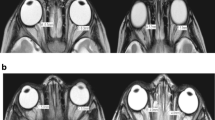Abstract
Objective
To determine the feasibility and test characteristics of optic nerve sheath diameter (ONSD) measured by ocular ultrasound as a screening tool for ventriculoperitoneal shunt (VPS) failure.
Methods
Prospective observational study using a convenience sample of children 6 months to 18 years of age, presenting to an academic pediatric emergency department for evaluation of possible VPS failure between September 2008 and March 2009. ONSD was measured by anterior transbulbar and lateral transbulbar techniques. Mean ONSD was compared between subjects with and without shunt failure, as determined by neurosurgical decision to operate.
Results
A total of 39 encounters were completed, including 20 VPS failures. The mean ONSD was 4.5 ± 0.9 and 5.0 ± 0.6 mm among encounters with and without shunt failure (p = 0.03), respectively. The mean ONSD was not statistically different when obtained by the anterior transbulbar vs. the lateral transbulbar approach (4.8 ± 1.0 vs. 4.7 ± 0.8 mm, p = 0.12). ONSD ultrasound had a sensitivity of 61.1 % (95 % CI 35.7–82.7) and specificity of 22.2 % (95 % CI 6.4–47.6 %) for detecting shunt failure in this sample.
Conclusions
ONSD ultrasound does not appear to be a useful primary screening tool in emergency department evaluation of VPS failure. There was no difference between the anterior transbulbar approach and the lateral transbulbar approach. Children with VPS in our sample have larger ONSD measurements than in previously reported studies.

Similar content being viewed by others
References
Ballantyne J, Hollman AS, Hamilton R, Bradnam MS, Carachi R, Young DG, Dutton GN (1999) Transorbital optic nerve sheath ultrasonography in normal children. Clin Radiol 54(11):740–742
Blehar DJ, Gaspari RJ, Montoya A, Calderon R (2008) Correlation of visual axis and coronal axis measurements of the optic nerve sheath diameter. J Ultrasound Med: Off J Am Inst Ultrasound Med 27(3):407–411
Byrne SF (1986) Standardized echography of the eye and orbit. Neuroradiology 28(5–6):618–640
Copetti R, Cattarossi L (2009) Optic nerve ultrasound: artifacts and real images. Intensive Care Med 35(8):1488–1489. doi:10.1007/s00134-009-1494-4, author reply 1490–1481
Geeraerts T, Launey Y, Martin L, Pottecher J, Vigue B, Duranteau J, Benhamou D (2007) Ultrasonography of the optic nerve sheath may be useful for detecting raised intracranial pressure after severe brain injury. Intensive Care Med 33(10):1704–1711. doi:10.1007/s00134-007-0797-6
Hansen HC, Helmke K (1997) Validation of the optic nerve sheath response to changing cerebrospinal fluid pressure: ultrasound findings during intrathecal infusion tests. J Neurosurg 87(1):34–40. doi:10.3171/jns.1997.87.1.0034
Helmke K, Hansen HC (1996) Fundamentals of transorbital sonographic evaluation of optic nerve sheath expansion under intracranial hypertension. I. experimental study. Pediatr Radiol 26(10):701–705
Iskandar BJ, Sansone JM, Medow J, Rowley HA (2004) The use of quick-brain magnetic resonance imaging in the evaluation of shunt-treated hydrocephalus. J Neurosurg 101(2 Suppl):147–151. doi:10.3171/ped.2004.101.2.0147
Kast J, Duong D, Nowzari F, Chadduck WM, Schiff SJ (1994) Time-related patterns of ventricular shunt failure. Childs Nerv Syst : ChNS : Off j Int Soc Pediatr Neurosurg 10(8):524–528
Kim TY, Stewart G, Voth M, Moynihan JA, Brown L (2006) Signs and symptoms of cerebrospinal fluid shunt malfunction in the pediatric emergency department. Pediatr Emerg Care 22(1):28–34
Le A, Hoehn ME, Smith ME, Spentzas T, Schlappy D, Pershad J (2009) Bedside sonographic measurement of optic nerve sheath diameter as a predictor of increased intracranial pressure in children. Ann Emerg Med 53(6):785–791. doi:10.1016/j.annemergmed.2008.11.025
McAuley D, Paterson A, Sweeney L (2009) Optic nerve sheath ultrasound in the assessment of pediatric hydrocephalus. Childs Nerv Syst 25(1):87–90. doi:10.1007/s00381-008-0713-6
Newman WD, Hollman AS, Dutton GN, Carachi R (2002) Measurement of optic nerve sheath diameter by ultrasound: a means of detecting acute raised intracranial pressure in hydrocephalus. Br J Ophthalmol 86(10):1109–1113
Pearce MS, Salotti JA, Little MP, McHugh K, Lee C, Kim KP, Howe NL, Ronckers CM, Rajaraman P, Sir Craft AW, Parker L, BerringtondeGonzalez A (2012) Radiation exposure from CT scans in childhood and subsequent risk of leukemia and brain tumors: a retrospective cohort study. Lancet 380(9840):499–505. doi:10.1016/S0140-6736(12)60815-0S0140-6736(12)60815-0
Pitetti R (2007) Emergency department evaluation of ventricular shunt malfunction: is the shunt series really necessary? Pediatr Emerg Care 23(3):137–141. doi:10.1097/PEC.0b013e3180328c77
Tayal VS, Neulander M, Norton HJ, Foster T, Saunders T, Blaivas M (2007) Emergency department sonographic measurement of optic nerve sheath diameter to detect findings of increased intracranial pressure in adult head injury patients. Ann Emerg Med 49(4):508–514. doi:10.1016/j.annemergmed.2006.06.040
Acknowledgments
We would like to thank Rochelle Fu PhD, I. Elaine Allen PhD MA, and Quynh Doan MD, MHSc, FRCPC for statistical analysis and review; Nathan Aras Teismann MD and Jane Yu PhD for manuscript review; and Kendall, Lisa, and Zane Allred for their participation in the photo session demonstrating ultrasound techniques. This research was funded by an Einstein research fellowship (Albert Einstein College of Medicine) awarded to M. Kennedy Hall MD.
Author information
Authors and Affiliations
Corresponding author
Rights and permissions
About this article
Cite this article
Hall, M.K., Spiro, D.M., Sabbaj, A. et al. Bedside optic nerve sheath diameter ultrasound for the evaluation of suspected pediatric ventriculoperitoneal shunt failure in the emergency department. Childs Nerv Syst 29, 2275–2280 (2013). https://doi.org/10.1007/s00381-013-2172-y
Received:
Accepted:
Published:
Issue Date:
DOI: https://doi.org/10.1007/s00381-013-2172-y




